QLIKVIEW LICENSE LEASING
QlikView Technical Brief
February 2012
qlikview.com�
Introduction
This document describes the process to allocate licenses to users from QlikView Server
(QVS) through the License Lease process. The document will discuss the approach adopted
by QlikTech to licensing QVS and Users and will not cover the licensing of additional
QlikView components such as Publisher, the SAP connector, WebParts or WorkBench.
Background
In early versions of QlikView prior to version 9, individual license keys were issued for QVS,
Publisher and additionally for each QlikView Developer or Professional User (Power user
requiring restricted development capabilities). Customers with large deployments consisting
of many developers and professional users were issued with numerous license keys that
needed to be allocated, installed and managed manually.
Each Developer or Professional user would be issued with a unique license key that would
need to be installed on their local workstation in order to remove the restrictions of the
QlikView trial software.
Typically a manual record of license allocations would need to be kept and maintained to
track which licenses belonged to whom. Such an approach could be prone to error or become
neglected increasing the likelihood of the customer breaching the licensing agreement.
Local license keys ensure offline development capabilities only and offer no online access
to documents on the server. Prior to version 9, additional Client Access Licenses (CALs)
would also be required for the QVS if developers were to have access to the documents
deployed on the server.
A smarter license management solution was required to ensure that organizations could
manage their QlikView licenses more effectively as employees joined and left the company.
A systematic mechanism was also required to safeguard customers from exceeding their
license allocation so as to ensure compliance at all times.
To tackle this problem and simplify license management for customers, the License Lease
feature was introduced in QlikView version 9 and has remained an integral part since.
License Lease
License Lease was introduced in version 9 for QVS environments and was designed to alleviate
the need to issue individual license keys to users requiring a desktop installation of QlikView by
combining all user licenses into the license key of the QVS. This ensured that a single license key
could be issued to customers for QVS which included the configurations for all associated users,
including offline developers. Furthermore, License Lease alleviates the need for Developers
wishing to have access to server documents to have a separate Local License key and a CAL
on the server by combining the two into a single Named CAL with License Leasing.
QlikView License Leasing | Page 2
�
Named Users (Developers) can now connect to an Enterprise version of QVS to lease their
local license giving them offline development capabilities for 30 days, after which they
must connect again to renew their lease. A lease is prolonged for 30 days each time a user
connects to the server.
A license lease can be obtained in one of two ways from a QlikView Enterprise or Small
Business Server and only by those who have a Named User CAL:
1. Opening a QlikView application on the Server through the IE Plug-in*
2. Opening an application on the server through the ‘Open in Server’ in QlikView desktop*
A license lease is issued to QlikView Desktop via the QVP protocol on Port 4747. Both
QlikView Desktop and the IE Plug-in communicate with the QlikView Server across this
encrypted port. A license lease cannot be issued via the AJAX client which runs on port 80.
A successful license lease will remove the restrictions of QlikView Personal Edition ensuring
users can open applications developed by others.
Figure 1. QlikView License Lease Process
2
1
3
4
4
4
4
* “Allow license lease” must be enabled on the QlikView Server Management console.
QlikView License Leasing | Page 3
�
License Types
License Lease is only available to those users who have obtained a Named User CAL
as this license type facilitates both online & offline (QlikView Desktop) use. Document
CALs, Session CALs & Usage CALs are all online licenses only meaning the user must be
connected to the server to analyze their data.
QlikView Test Server
In most cases, customers choose to replicate the licenses they have in production to a test
environment, utilizing the QlikView Test Server for this purpose. The QlikView Test Server
does not permit license leasing because it accepts that the User has already leased a
license from a QlikView Enterprise Edition Server and therefore does not require a second
licensing server. A QlikView developer only requires a single licensing server to be given
offline development capabilities removing the restriction of the Personal Edition. This does
not prohibit them in any way from creating and posting QlikView applications to any number
of additional servers.
Segregated Environments
In scenarios where the Developer is completely detached from the QlikView Enterprise
Server and is therefore unable to obtain a license lease via port 4747, no other option
exists other than to contact QlikTech who will issue Local License Keys that will need to be
installed locally.
For non-server environments, Local Licenses Keys must be issued for development.
Server Types
License Lease is available on the following server editions:
• QlikView Enterprise Server
• QlikView Small Business Server
License Lease is unavailable on the following server editions:
• QlikView Test Server
• QlikView Extranet Server
• QlikView Information Access Server
QlikView License Leasing | Page 4
�
Security Systems
The License Lease system has been based around a Windows User Account connecting
to a QlikView Server with authentication and then opening an application. Options exist for
implementing License Lease in non-Windows security environments, however this typically
requires custom development and is outside the scope if this document.
Multiple License Leases
A single user can lease up to two licenses to two separate workstations within a 24 hour
period. An attempt to lease a third license in a 24 hour period will be revoked if the same
User ID is used. Additionally, the existing license lease of the third machine, should there
be one previously existing, will be revoked in the case where the same User ID has leased
a license from two other workstations in the previous 24 hour period. The third machine will
however be able to lease a license after 24 hours have passed.
License Lease Period
The period of a license lease is set at 30 days and this cannot be altered.
How to Lease a License
AUTOMATICALLY LEASING A LICENSE FROM THE SERVER
You must ensure that License Leasing in enabled from the Server Management Console and
that the User has a Named CAL designated to them in the “Assigned CALs” tab or “Allow
Dynamic CAL Assignment” is enabled with at least one unallocated Named CAL available.
Figure 2. “Allow license lease” option on QlikView Management Console
QlikView License Leasing | Page 5
�
This is how an unlicensed version of QlikView (QlikView Personal Edition) appears prior to a
license lease being obtained from the QlikView Server.
Figure 3. Unlicensed version of QlikView (QlikView Personal Edition)
Start QlikView Desktop and from the ‘Settings’ menu select ‘User Preferences’ followed by
the ‘Locations’ tab. Highlight “QlikView Server Access Point (URL)” and press the ‘Modify’
button. Enter the Access Point URL and press ‘OK’.
From the ‘Tools’ menu select ‘Open QlikView AccessPoint’. When the QlikView Access Point
displays showing available documents, click to open a document.
At this point, QlikView will lease a license from the server (if License Leasing is enabled on
the Server) ensuring the copy of QlikView is fully licensed.
A Leased License will expire if it has not been updated for 30 days. Updating a Leased
License is done automatically in the background, provided that QlikView can connect to a
QlikView Server where you have a Named CAL. It can also be done manually by opening a
file on the server, please see the next section.
QlikView License Leasing | Page 6
�
MANUALLY LEASING A LICENSE FROM THE SERVER
You must ensure that License Leasing in enabled from the Server Management Console and
that the User has a Named CAL designated to them in the “Assigned CALs” tab or “Allow
Dynamic CAL Assignment” is enabled with at least one unallocated Named CAL available.
Figure 4. “Allow license lease” option on QlikView Management Console
This is how an unlicensed version of QlikView (QlikView Personal Edition) appears prior to a
license lease being obtained from the QlikView Server.
Figure 5. Unlicensed version of QlikView (QlikView Personal Edition)
QlikView License Leasing | Page 7
�
To Lease a license, go to File > Open in Server… from the toolbar at the top.
Figure 6. Connect to Server wizard
Specify the server name and hit ‘Connect’. This action will lease a license from the server.
Hit the ‘Cancel’ button to return to the QlikView Start Page. A message will be displayed
stating that you are leasing a license from the server.
Figure 7. Licensed version of QlikView
QlikView License Leasing | Page 8
�


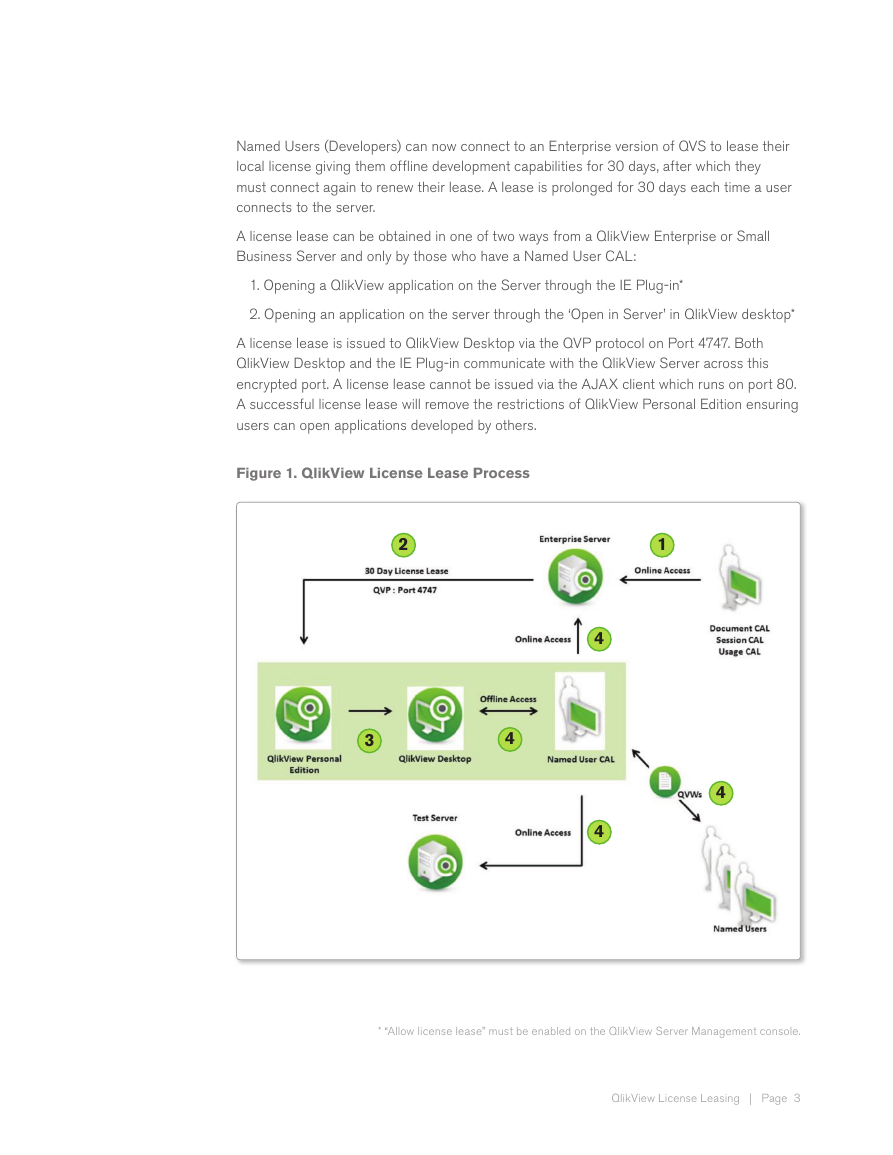
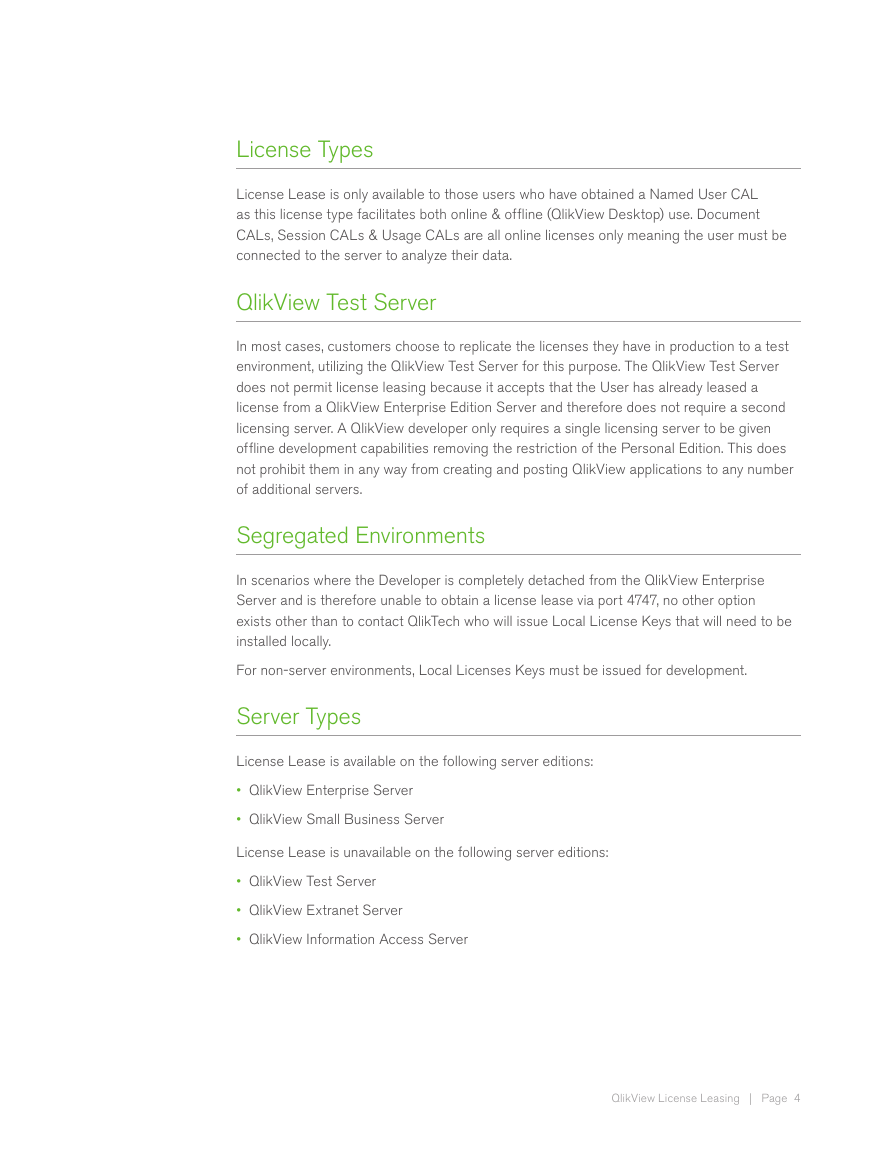
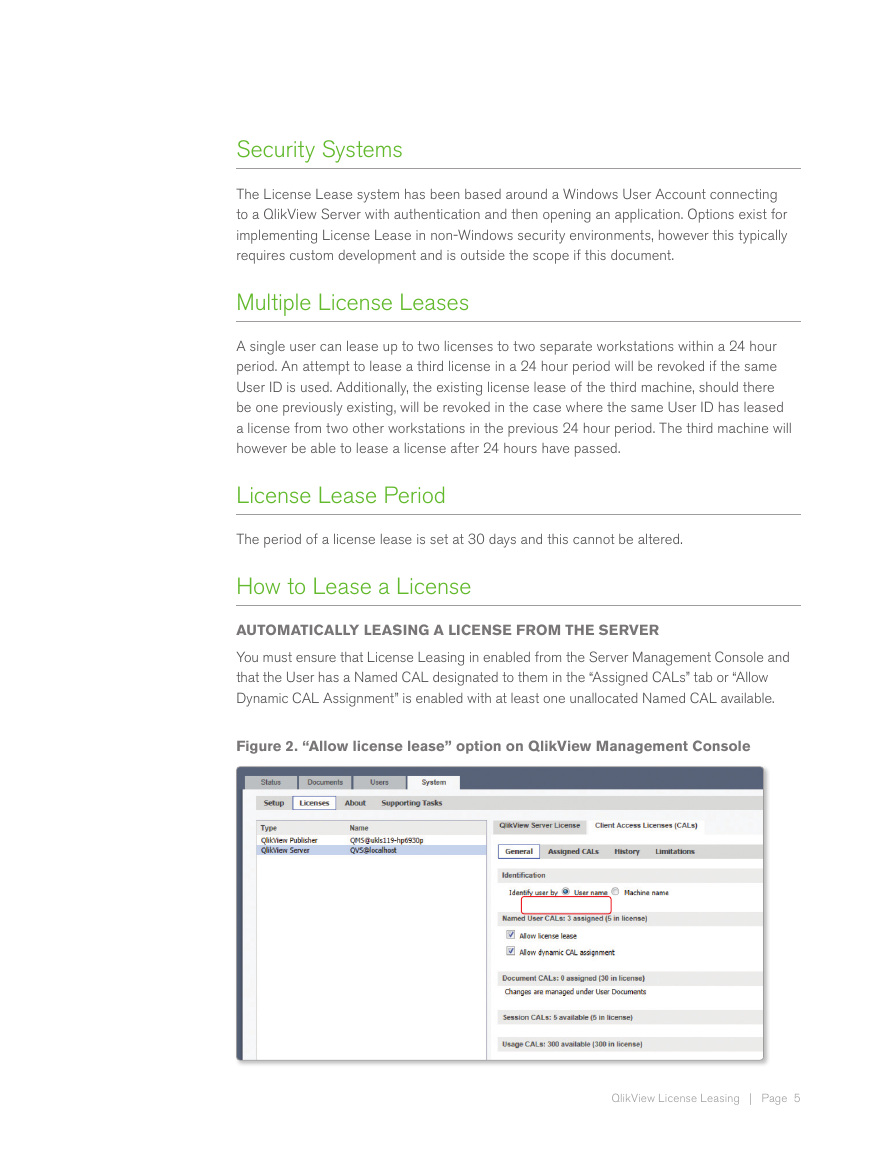
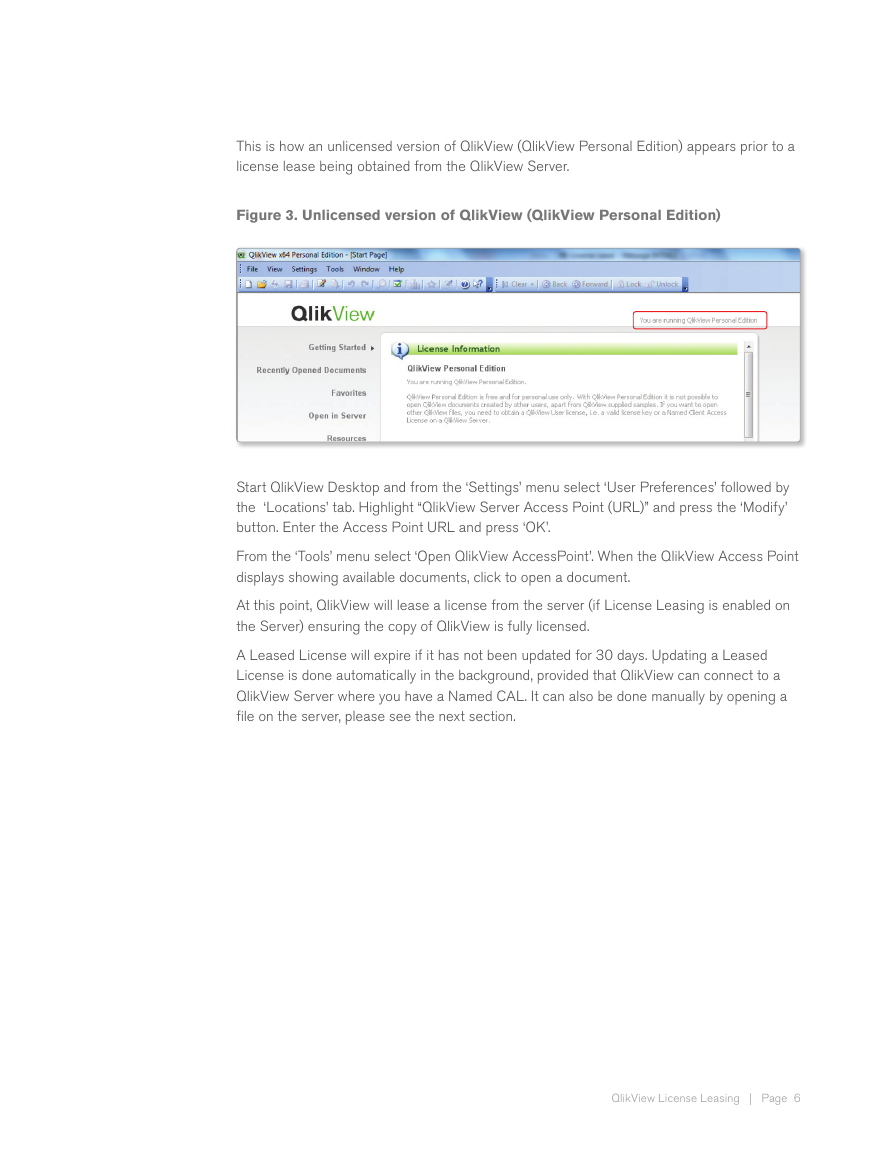

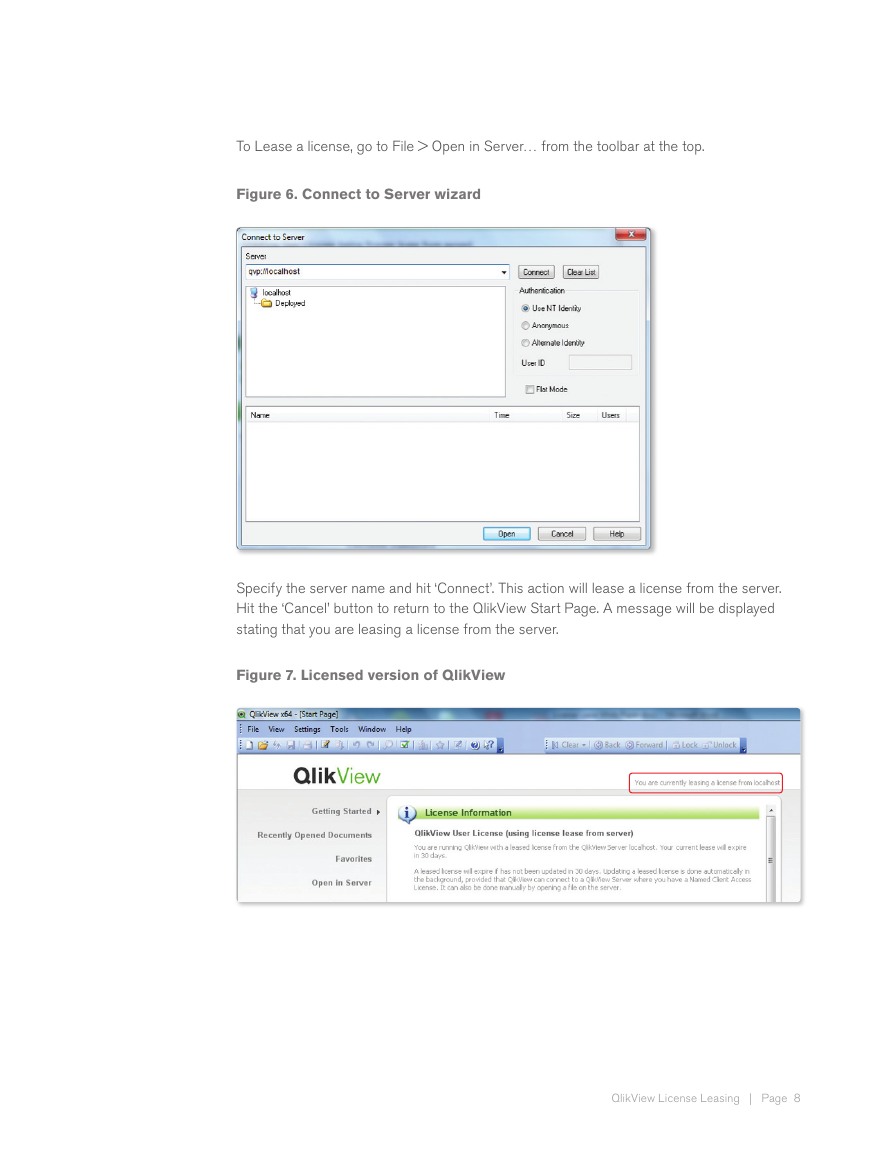








 2023年江西萍乡中考道德与法治真题及答案.doc
2023年江西萍乡中考道德与法治真题及答案.doc 2012年重庆南川中考生物真题及答案.doc
2012年重庆南川中考生物真题及答案.doc 2013年江西师范大学地理学综合及文艺理论基础考研真题.doc
2013年江西师范大学地理学综合及文艺理论基础考研真题.doc 2020年四川甘孜小升初语文真题及答案I卷.doc
2020年四川甘孜小升初语文真题及答案I卷.doc 2020年注册岩土工程师专业基础考试真题及答案.doc
2020年注册岩土工程师专业基础考试真题及答案.doc 2023-2024学年福建省厦门市九年级上学期数学月考试题及答案.doc
2023-2024学年福建省厦门市九年级上学期数学月考试题及答案.doc 2021-2022学年辽宁省沈阳市大东区九年级上学期语文期末试题及答案.doc
2021-2022学年辽宁省沈阳市大东区九年级上学期语文期末试题及答案.doc 2022-2023学年北京东城区初三第一学期物理期末试卷及答案.doc
2022-2023学年北京东城区初三第一学期物理期末试卷及答案.doc 2018上半年江西教师资格初中地理学科知识与教学能力真题及答案.doc
2018上半年江西教师资格初中地理学科知识与教学能力真题及答案.doc 2012年河北国家公务员申论考试真题及答案-省级.doc
2012年河北国家公务员申论考试真题及答案-省级.doc 2020-2021学年江苏省扬州市江都区邵樊片九年级上学期数学第一次质量检测试题及答案.doc
2020-2021学年江苏省扬州市江都区邵樊片九年级上学期数学第一次质量检测试题及答案.doc 2022下半年黑龙江教师资格证中学综合素质真题及答案.doc
2022下半年黑龙江教师资格证中学综合素质真题及答案.doc